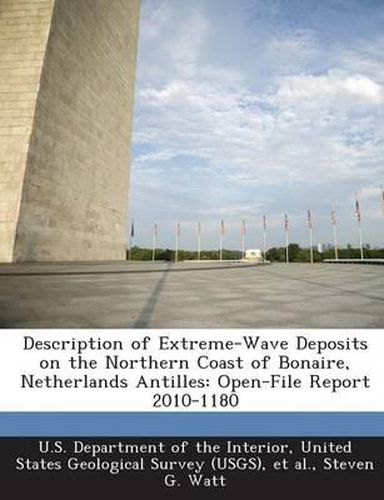Readings Newsletter
Become a Readings Member to make your shopping experience even easier.
Sign in or sign up for free!
You’re not far away from qualifying for FREE standard shipping within Australia
You’ve qualified for FREE standard shipping within Australia
The cart is loading…






To develop a better understanding of the origins of extreme-wave deposits and to help assess the potential risk of future overwash events, a field mapping survey was conducted in November 2006 on the northern coast of Bonaire, Netherlands Antilles. Deposits were mapped and analyzed to help develop a systematic sedimentological approach to distinguish the type of extreme-wave event (tsunamis or storms) or combination of events that formed and modified the deposits over time. Extreme-wave deposits on the northern coast of Bonaire between Boka Onima and Boka Olivia have formed sand sheets, poly-modal ridge complexes, and boulder fields on a Pleistocene limestone platform 3?8 meters above sea level. The deposits exhibit characteristics that are consistent with both large storm and tsunami processes that often overlap one another. Sand sheets occur as low-relief features underlying and incorporated with boulder field deposits. The seaward edge of ridge complexes are deposited up to 70 m from the shoreline and can extend over 200 m inland. Over 600 clasts were measured in fields and range in size from coarse gravel to fine block, weigh up to 165 metric tons, and are placed over 280 m from the shoreline. Our analyses indicate that the deposits may have been produced by a combination of hurricane and tsunami events spanning 10s to 1000s of years. Comparing the different deposit morphologies between study sites highlights the importance of shoreline orientation to the distribution of extreme-wave deposits onshore. However, further investigation is required to fully understand the processes that have produced and modified these deposits over time.
$9.00 standard shipping within Australia
FREE standard shipping within Australia for orders over $100.00
Express & International shipping calculated at checkout
To develop a better understanding of the origins of extreme-wave deposits and to help assess the potential risk of future overwash events, a field mapping survey was conducted in November 2006 on the northern coast of Bonaire, Netherlands Antilles. Deposits were mapped and analyzed to help develop a systematic sedimentological approach to distinguish the type of extreme-wave event (tsunamis or storms) or combination of events that formed and modified the deposits over time. Extreme-wave deposits on the northern coast of Bonaire between Boka Onima and Boka Olivia have formed sand sheets, poly-modal ridge complexes, and boulder fields on a Pleistocene limestone platform 3?8 meters above sea level. The deposits exhibit characteristics that are consistent with both large storm and tsunami processes that often overlap one another. Sand sheets occur as low-relief features underlying and incorporated with boulder field deposits. The seaward edge of ridge complexes are deposited up to 70 m from the shoreline and can extend over 200 m inland. Over 600 clasts were measured in fields and range in size from coarse gravel to fine block, weigh up to 165 metric tons, and are placed over 280 m from the shoreline. Our analyses indicate that the deposits may have been produced by a combination of hurricane and tsunami events spanning 10s to 1000s of years. Comparing the different deposit morphologies between study sites highlights the importance of shoreline orientation to the distribution of extreme-wave deposits onshore. However, further investigation is required to fully understand the processes that have produced and modified these deposits over time.